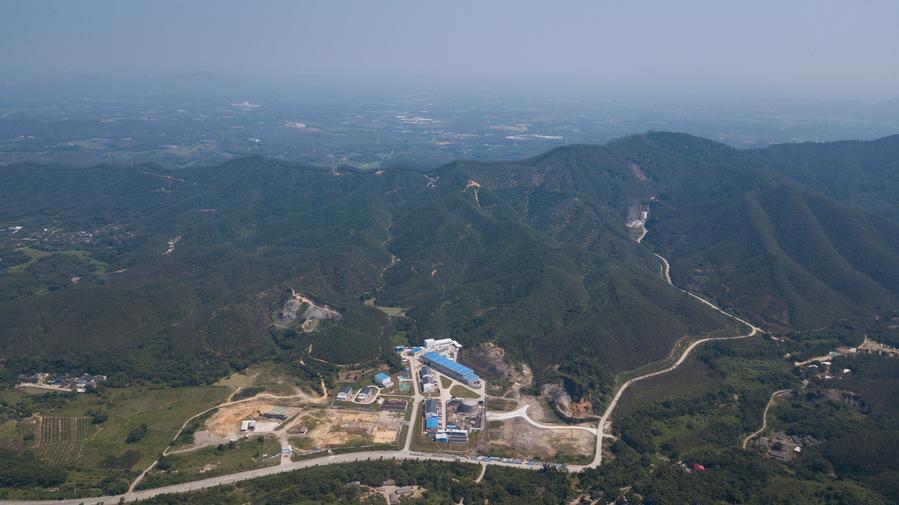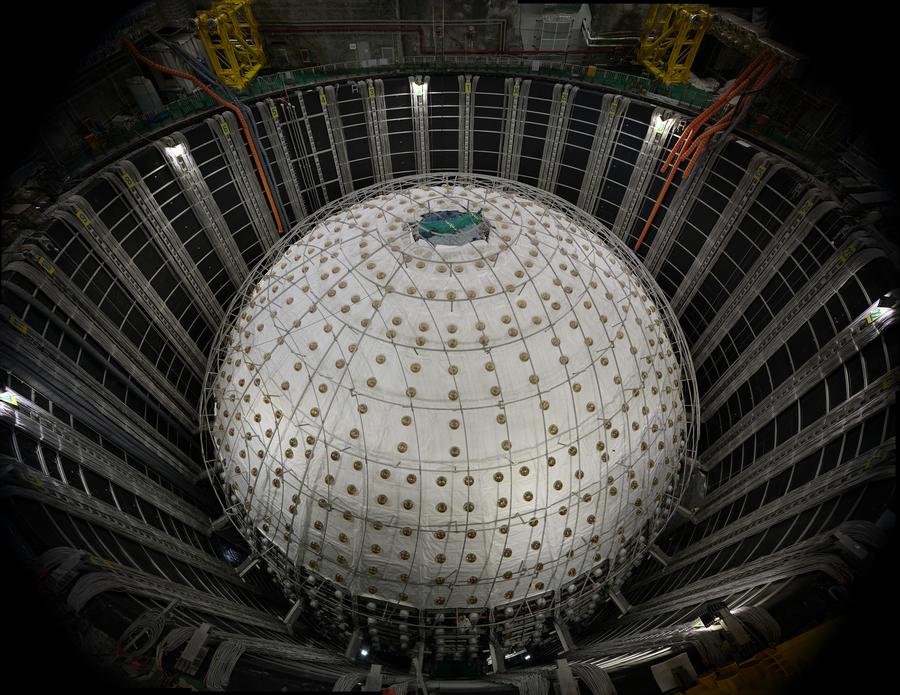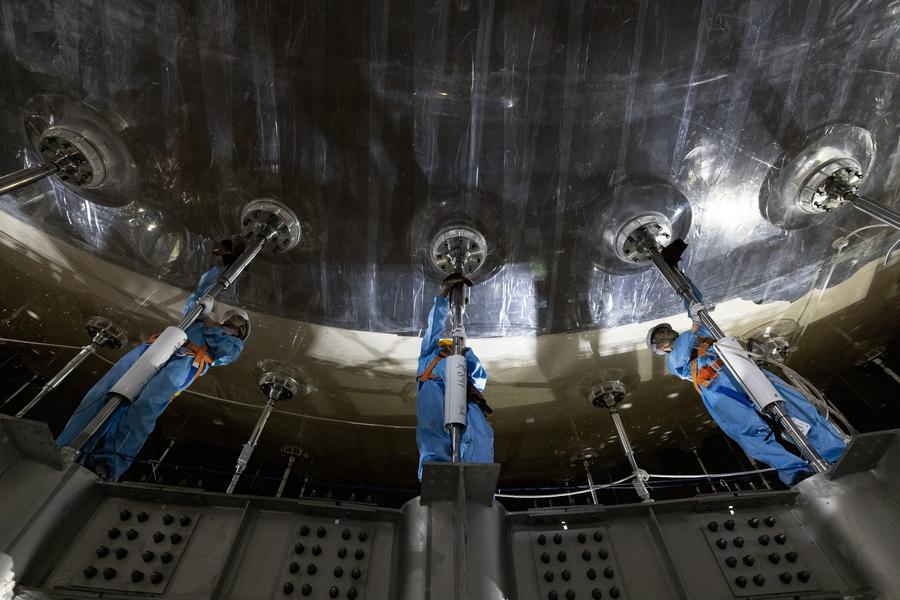彩娱乐官网 Update: China builds huge underground transparent sphere to trap "ghost particles"

GUANGZHOU, Oct. 11 (Xinhua) -- China has constructed the world's largest transparent spherical detector 700 meters underground to capture elusive neutrinos彩娱乐官网, often dubbed "ghost particles," to unravel the secrets of the infinitesimally small and the infinitely vast in the universe.
The 12-story-tall acrylic sphere with a diameter of 35.4 meters, buried deep in a granite layer of a hill in Kaiping, Jiangmen City in south China's Guangdong Province, is the core part of the Jiangmen Underground Neutrino Observatory (JUNO), a gigantic and complex scientific facility.
The construction of the challenging project, launched by the Chinese Academy of Sciences (CAS) and the Guangdong government in 2015, has entered the final stage. Installation of the entire device is expected to be completed by the end of November, and the full operation of the facility is scheduled for August 2025, according to the Institute of High Energy Physics (IHEP) of the CAS, the project's leading institution.
As one of the world's most powerful experiments to uncover neutrino mystery, JUNO is expected to operate for at least 30 years. The observatory is designed to help scientists better understand the neutrino mass hierarchy by detecting reactor neutrinos from the nearby Yangjiang and Taishan nuclear power plants with an unprecedented 3 percent energy resolution, said Wang Yifang, chief scientist of JUNO and head of the IHEP.
Understanding the neutrino mass hierarchy could have huge implications for physical models of the universe and for the research on cosmic evolution, said Wang.
The facility will also help scientists conduct other cutting-edge studies such as observing supernova, atmospheric and solar neutrinos.

GHOST PARTICLES
Neutrinos, the smallest and lightest among the 12 elementary particles that make up the material world, are electrically neutral and travel at a speed close to that of light. Since the Big Bang, they have permeated the entire universe, generated in various phenomena, such as nuclear reactions inside stars, supernova explosions, the operation of nuclear reactors and the radioactive decay of substances in rocks.
Since neutrinos rarely interact with ordinary matter, they can easily zip through our body, buildings or the entire Earth without being felt, hence earning the nickname "ghost particles." Due to their elusive nature, neutrinos are the least understood fundamental particles, requiring massive detectors to capture their faintest traces.
Scientists have found that neutrinos can be classified into three types, which are capable of transforming into one another, a phenomenon known as neutrino oscillation.
Under the standard model of particle physics, neutrinos shouldn't have any mass. The phenomenon of neutrino oscillation proves that neutrinos have tiny masses, which is an experimental phenomenon that exceeds the standard model, pointing to new physics to enhance our understanding of the universe, Wang said.
Scientists around the world have studied neutrinos for over half a century, yet numerous mysteries about the tiny particles remain unsolved, such as how do the masses of the three known types of neutrinos compare to one another? Are neutrinos and their antiparticles the same particles? Are neutrinos part of the cause of the asymmetry between matter and antimatter in the universe?
Despite their extremely small mass, neutrinos are one of the building blocks that make up the material world. They carry crucial knowledge about the universe, offering profound insights into the fundamental structure of the microscopic world and the origin and evolution of the macroscopic universe.
"By studying neutrinos, we can understand why the universe has become what it is today, and what will be the future of the universe," Wang said.
Neutrino research is at the forefront of particle physics, astrophysics and cosmology. Several significant breakthroughs in neutrino research have been honored with the Nobel Prize.

UNPRECEDENTED EXPERIMENT
A hill in Kaiping, 53 kilometers from both Yangjiang and Taishan nuclear power plants, was chosen to be the site of JUNO, where the oscillation effect of neutrinos from the reactors of the power plants is most pronounced. Additionally, the rocks of the hill serve as a shield against interference from cosmic rays, according to Cao Jun, deputy director of the IHEP.
The gigantic sphere, weighing approximately 600 tonnes, composed of 265 pieces of 12-centimeter-thick acrylic panels, has been meticulously assembled from top to bottom by the construction team.
"Compared to the sphere's enormous size, the 12-centimeter thickness is proportionally as thin as an eggshell," said Yang Changgen, deputy general manager of JUNO.
The sphere is fixed by a steel frame in the center of a 44-meter-deep cylindrical water tank. The interior of the acrylic sphere will be filled with 20,000 tonnes of liquid that can "flash" when detecting neutrinos. The water tank outside the sphere will be filled with 35,000 tonnes of ultra-pure water, which is used to shield cosmic rays and radioactive background from rocks.
The main component of the liquid inside the sphere is alkyl benzene, a key ingredient in detergents, which is non-toxic, easily biodegradable, and has a low risk of fire hazard, Cao said.
When passing through the sphere, neutrinos have a small chance of bumping into the hydrogen nuclei in the liquid, triggering extremely faint flashes, which can be detected by the surrounded photo-multiplier tubes.
In order to construct this massive and complex scientific device, the team of scientists and engineers have overcome a series of unprecedented technological challenges.
The team excavated and built an underground cavern to accommodate the facility with its arched roof spanning 49.5 meters, setting a record in China.
To make the sphere and the liquid inside as transparent as possible, the total amount of dust in the 20,000 tonnes of liquid must not exceed 0.008 grams, said Yang.
The team have developed photo-multiplier tubes with independent intellectual property rights, boasting the highest photon detection efficiency. They have also created an underwater explosion-proof system for photo-multiplier tubes, and conducted over 30 underwater explosion-proof experiments.
They have innovated the design of the underwater electronic components, achieving aerospace-level reliability with a requirement of a failure rate of less than 0.5 percent within six years.
Once completed, JUNO is expected to capture approximately 40 reactor neutrinos, several atmospheric neutrinos, one geoneutrino and thousands of solar neutrinos every day. With data collection over a period of six years, it is estimated that around 100,000 neutrinos can be detected by the lab, according to Cao.
JUNO is the second China-based neutrino project, following the Daya Bay Reactor Neutrino Experiment in Guangdong. Chinese and foreign physicists announced in 2012 that they had measured a third type of neutrino oscillation in the Daya Bay experiment. The scale of JUNO is much larger than the Daya Bay experiment with more sensitive detection.
Over 700 scientists from 74 institutions in 17 countries and regions including France, Italy, Russia, Germany and Belgium have joined the JUNO international collaboration. ■
那么,在白垩纪生物如此多样性的前提下彩娱乐官网,彩娱乐合作加盟飞机号@yy12395海陆空三大领域的顶级掠食者都是什么史前巨兽呢?今天老道就为大家盘点一下。
最新资讯
- 2024-12-15彩娱乐官网 难相处, 不是一又友! 皮蓬挖苦乔丹: 莫得我, 他和詹姆斯差未几
- 2024-08-03彩娱乐官网 玩文玩, 你悟出什么酷爱酷爱?
- 2024-05-24彩娱乐官网 产业基金、国资平台、私募基金共同参与 念念必驰完成5亿元融资
- 2024-10-14彩娱乐官网 抚顺特钢: 第一大鞭策由东北特钢变更为沙钢集团
- 2024-09-05彩娱乐官网 国度统计局:10月范围以上工业增多值同比增长5.3% 主要经济方针回升昭着
